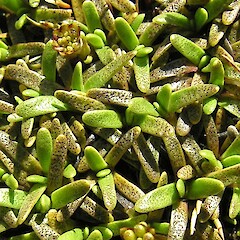Abrotanella caespitosa
Family
Asteraceae
Flora category
Vascular – Native
Endemic taxon
Yes
Endemic genus
No
Endemic family
No
Structural class
Herbs - Dicotyledonous composites
NVS code
The National Vegetation Survey (NVS) Databank is a physical archive and electronic databank containing records of over 94,000 vegetation survey plots - including data from over 19,000 permanent plots. NVS maintains a standard set of species code abbreviations that correspond to standard scientific plant names from the Ngä Tipu o Aotearoa - New Zealand Plants database.
ABRCAE
Chromosome number
2n = 18
Current conservation status
The conservation status of all known New Zealand vascular plant taxa at the rank of species and below were reassessed in 2017 using the New Zealand Threat Classification System (NZTCS) – more information about this can be found on the NZTCS website. This report includes a statistical summary and brief notes on changes since 2012 and replaces all previous NZTCS lists for vascular plants.
Please note, threat classifications are often suggested by authors when publications fall between NZTCS assessment periods – an interim threat classification status has not been assessed by the NZTCS panel.
- Conservation status of New Zealand indigenous vascular plants, 2017 . 2018. Peter J. de Lange, Jeremy R. Rolfe, John W. Barkla, Shannel P. Courtney, Paul D. Champion, Leon R. Perrie, Sarah M. Beadel, Kerry A. Ford, Ilse Breitwieser, Ines Schönberger, Rowan Hindmarsh-Walls, Peter B. Heenan and Kate Ladley. Department of Conservation. Source: NZTCS and licensed by DOC for reuse under the Creative Commons Attribution 4.0 International licence.
2017 | Not Threatened
Previous conservation statuses
2012 | Not Threatened
2009 | Not Threatened
2004 | Not Threatened
Distribution
North and South Islands. Ruahine and Tararua Range, Mount Taranaki in the North; widespread from Kahurangi to Fiordland National parks in the South.
Habitat
Montane to subalpine 900-1800m Often common but inconspicuous in bogs and permanently wet hollows, including snowbanks.
Wetland plant indicator status rating
Information derived from the revised national wetland plant list prepared to assist councils in delineating and monitoring wetlands (Clarkson et al., 2021 Manaaki Whenua – Landcare Research Contract Report LC3975 for Hawke’s Bay Regional Council). The national plant list categorises plants by the extent to which they are found in wetlands and not ‘drylands’. The indicator status ratings are OBL (obligate wetland), FACW (facultative wetland), FAC (facultative), FACU (facultative upland), and UPL (obligate upland). If you have suggestions for the Wetland Indicator Status Rating, please contact: [Enable JavaScript to view protected content]
FACW: Facultative Wetland
Usually is a hydrophyte but occasionally found in uplands (non-wetlands).
Detailed description
Mat forming herb, up to 1 m or more across. Branching and rooting stems with very small leafy rosettes; stock rather stout; Leaves rosulate, at nodes, (6-) 10-15 × 1-1.5 mm, narrow-linear, obtuse, spreading to recurved, coriaceous, mottled dark green. Peduncles (sunk among the leaves at stem tips when ripening stalks elongate) up to 10 mm long in fruit, with 1-2 short linear bracts or nude. Capitula up to 2-4 mm diameter; phyllaries 6-8, approximately 2 mm long, broad-oblong, obtuse, veins often obscure, margins scarious. Florets 6-8, not strongly dimorphic; achenes approximately 2 mm. long, fusiform to obovoid, glabrous, obscurely ribbed to smooth.
Similar taxa
Could be confused with A. fertilis, which has longer (20 mm) peduncles when in fruit.
Flowering
October-February
Fruiting
November-March
Life cycle
Cypselae are primarily dispersed by wind (Thorsen et al., 2009).
Etymology
abrotanella: Little Artemisia (known as Abrotanus by ancient herbalists)
caespitosa: From the Latin caespes ‘tuft’ or ‘sod of turf’, meaning growing in tufts or patches
Where To Buy
Not commercially available.
Attribution
Description adapted by M. Ward from Mark (2012) and Allan (1961).
References and further reading
Allan, H. H. 1961. Flora of New Zealand. Vol. 1. Wellington: Government Printer. 693 pp.
Mark, A. F. 2012. Above the Treeline: A Nature Guide to Alpine New Zealand. Craig Potton Publishing, Nelson. 199 pp.
Thorsen, M. J.; Dickinson, K. J. M.; Seddon, P. J. 2009. Seed dispersal systems in the New Zealand flora. Perspectives in Plant Ecology, Evolution and Systematics 11(4): 285-309.











